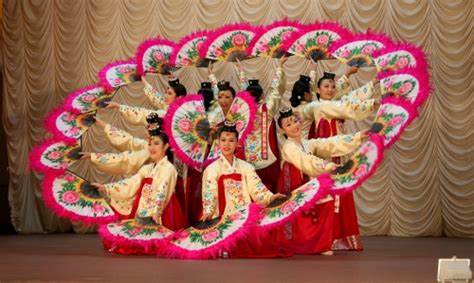
Korean traditional dance has three main styles. The first is shamanistic which is an early expression of religiosity and spirituality. This style of dance came from early Korean history. The second is folk which also likely was a very early style of dance from Korean history. Folk dance came from villages and it is an expression of the collective since it was a communal activity for commoners. The third style is court dance which is the most recently formed style of traditional dance. This dance came around once more highly structured societies arose like kingdoms. It is an expression of highly structured society and is highly based on Confucianism.
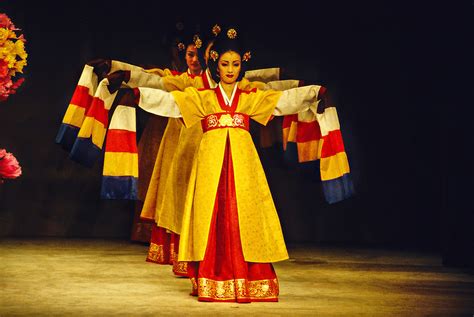
The spirit and main themes of Korean dance come from Eastern religion and philosophy. Korean dance is very old and it goes back to hunter-gatherer times. Because of this, the dance is mainly derived from the rhythm of nature and self-renunciation. During hunter-gatherer times it was very important for the people to be in sync with nature because they relied on it for survival. So this dance, especially the shamanistic style, is infused with the belief that people must adapt to nature and that any behavior that damages nature is not conducive to a good life. Korean dance is said to also embody the art of simple grace “organization of the unplanned” and a spirit of fun (File, 11). Korean dance is very free-flowing and all about self-expression and creativity.
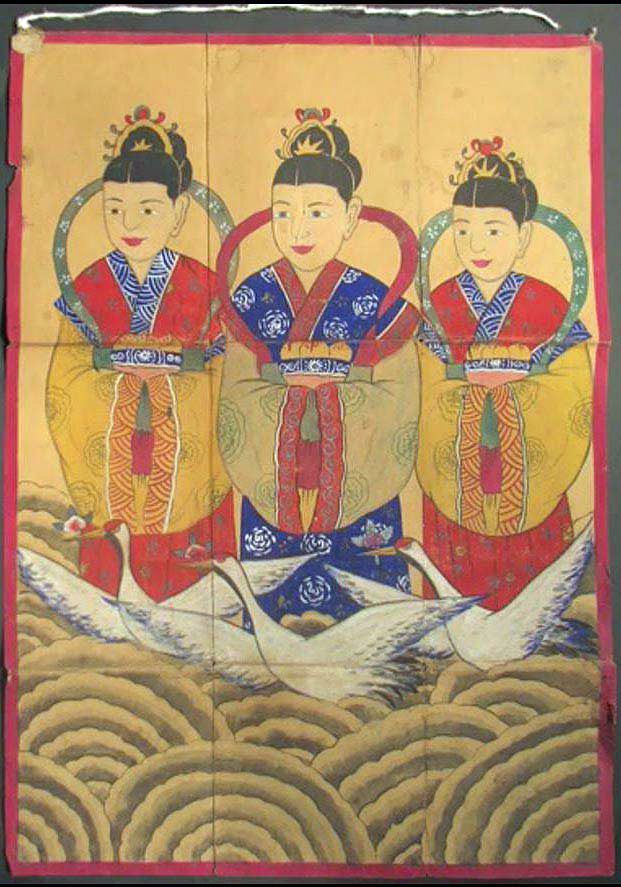
There are very common movements and props used in Korean dance to demonstrate certain emotions or aesthetics. An up and down movement of the shoulders, commonly referred to as verticality, is used in dances to convey a sense of pain or anguish which is then followed by a feeling of release (File, 17). This verticality is present mostly in court dances and dances that were influenced by Buddhism. Another way to convey emotion is through common props like swords and fans. Swords represent masculinity and warriors and sword dances typically resemble a war game. Sword dances are also present in Chinese and Japanese dances but Korean sword dances are different because they are more graceful, livelier, and have varied movements and rhythms. Fans are used to symbolize awakening and stillness; common Korean aesthetics. Dances that use fans typically begin in stillness with the dancer’s faces hidden behind the fans; the slow revealing of their faces from behind the fan symbolizes awakening.

Korean dance has common themes that distinguish this dance from others. One of the main themes is self-expression. Korean folk dance is very improvisational, it has no set movements or format and it is more for the dancers to express themselves. Folk dance is judged not by technical skill but by how well the dancer expresses themselves. Another common theme is the expression of Han and Sinmyeong. Han is characterized by profound grief and sadness, typically bitter feelings felt among the people. This feeling is typically rooted in social injustices such as invasions from neighboring countries. This feeling is physically represented by long and slow dragging movements of the feet and stiff shoulder movements during the dance. Sinmyeong is the ecstatic happiness that comes after han; it is the moment of “artistic ecstasy or exhilaration that occurs at that final dramatic moment when tears turn to laughter and darkness turns to light”(File, 14). Sinmyeong is the releasing of han feelings and the utopia of a perfect world after death and darkness. Another common theme is an aesthetic that is typically used during the fan dances, stillness. Stillness is a technical movement that builds anticipation for the audience. After the stillness, the tension becomes released after the movement of the dancers picks back up. For example, in the fan dance, the stillness of the dancers with their fans held in front of their faces builds anticipation. Once the fans move away from their faces, the tension is released and the awakening has begun. Seungmu, a very early shamanistic dance form, demonstrates that Korean dancers “move through their positions rather than arriving at them, creating an effect of what is sometimes called a ‘visual sigh of relief’” (File, 14-15). This “‘visual sigh of relief’” is an aesthetic used throughout most of Korean traditional dances.
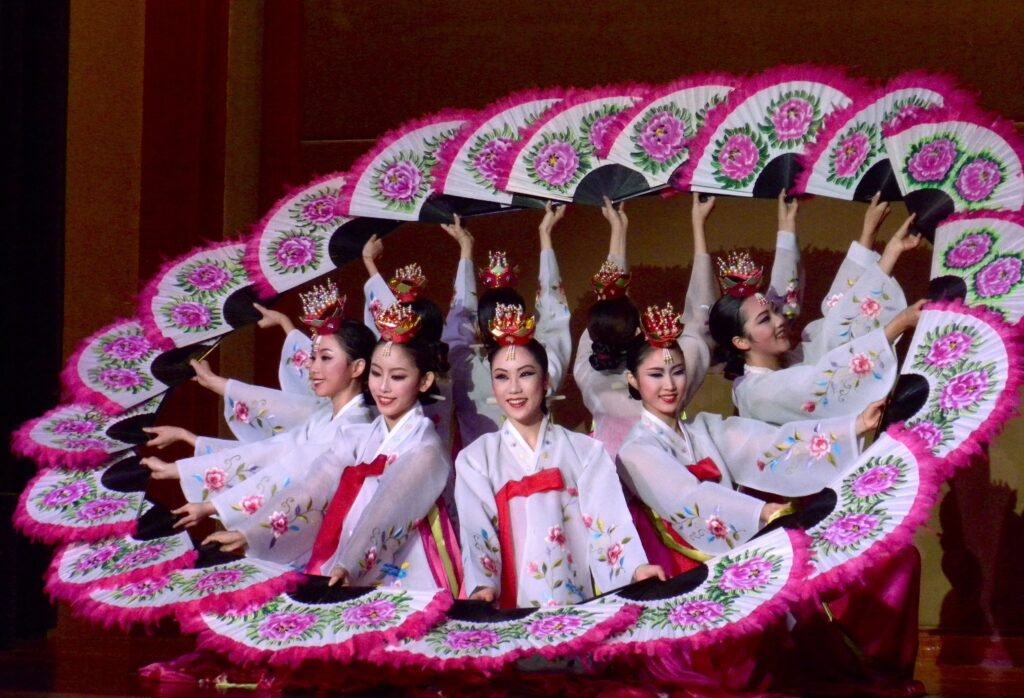
Korean folk dance came from feudal Korea, specifically from the non-ruling class. This refers mainly to commoners like farmers, traders, fishermen, and merchants; acting as both observers and participants of the dance. Folk dance helped to liven work on the fields, it promoted social cohesion, and it relieved the emotional anguish and stress of everyday life. Many jobs did not allow much room for creativity and self-expression so dance became their creative outlet. Folk dance is also heavily tied to seasonal events like harvests and other celebrations. One Korean folk dance that was very common is Talchum, a Korean folk mask dance. It was made to perform rites for bountiful harvests and the prosperity of the village. This dance has heavy themes of classism; it juxtaposes the everyday life of a commoner with the corruption and immorality of the aristocracy.
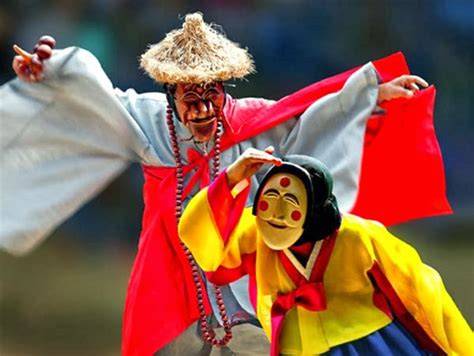
Ritual dance, or shamanistic dance, was used to spread Buddhism in Korea during the Silla period (57 BC – 935 AD). This is one of the earliest expressions of dance in Korea and it is mainly used for religious purposes: performing rites and prayers. The Shamanistic dance mumu is the oldest known dance in Korean history and a good example of ritual dance. It was performed as a rite for the well being and prosperity of the village that can last for several days. This dance uses offerings and bells to attract attention from the gods for their blessings. The most essential part of this dance is that by the end of it, the shaman is said to be possessed by a spirit or god.

Court dances are important dances that pertain to the ruling class and structured society. They were known as jeongjae which means “dedication to the monarch” or “dedication talent” since it was performed in front of high-ranking officials or guests as an act of honor. Court dance is different from folk dance and shamanistic dance since it is not an expression of self but national sentiment. Folk dance is improvisational but court dance differs since it has strict rules for the movements and format of the dance. Court dance has six main themes; all of which have to do with the success of the royal court, the king, the royal family, and the nation as a whole. The movements of court dance are also mainly based on Eastern philosophies like the theory of yin and yang, and the 5 elements (water, wood, fire, earth, and metal).
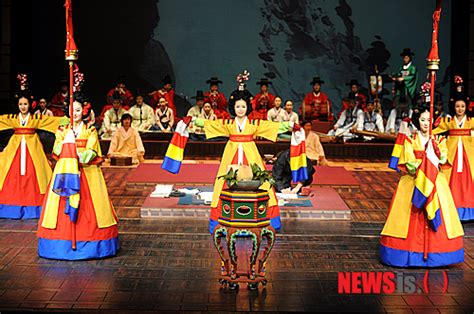
Court dance is broken up into two distinct types: Dangak jeongjae and Hyangak jeongjae. Dangak jeongjae was brought from China during the Goryeo Dynasty and Hyangak jeongjae is native Korean court dance. These two styles of court dance can be distinguished from each other by examining the performances. Dangak jeongjae uses pole bearers, an opening refrain, and a song celebrating the king; things that are not used in native Korean dances. With Hyangak jeongjae, the dancers bow when they enter the stage and again when they leave, the songs are in native Korean, and the dancers do not hold fans or parasols which are all Chinese ceremonial items.
Many ancient relics and documents that were a record of Korea’s traditional dance have been lost to time or destroyed in war so there is not a solid idea of how dance fits into ancient Korea. But it is known that Korean dance has been around for thousands of years, the earliest record being from the Bangudae rock carving in the city of Ulsan. This carving depicts prehistoric Korean dance traditions from hunter-gatherer times. It shows hunters (shaman-like men) and animals; the dance underscores the relationship between man and the animals they need for survival. In the dance, the hunters hold spears, arrows, and other instruments while wearing the pelts/ costumes of the animals (File, 57). There is a theory that these dances were performed before a hunt to wish for safety and good bounty and they were also performed after a hunt to give thanks and celebrate. The carving also depicted elements of folk dance: celebrating milestones, special events, and communal celebrations.
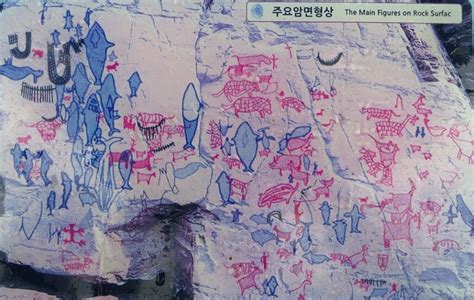
Korea’s first kingdom was Gojoseon and this led to the focus of dance shifting from hunting to agriculture. Since kingdoms lead to a more highly structured society, they began to rely on agriculture and harvests to support the kingdom. So dance performances included rites to heaven, shaman dances, funerals, healing, and farming prayers (dances for harvests instead of for hunts). Then came the Three Kingdoms era from 57 BC to 669 AD. The kingdoms were Goguryeo, Baekje, and Silla. Buddhism was very prominent in the arts of all of these kingdoms. Goguryeo received many influences from China and other countries out west. This kingdom is best known for its tomb murals, specifically The Muyongchong (Tomb of Dancers). These tombs have mural paintings depicting their art and culture as well as how they sent people into the afterlife, with song and dance. Not much is known about this kingdom and their culture other than what can be inferred from these tomb murals. Baekje had a geography of flat plains so farming was pretty straightforward which left an excess of time to cultivate the arts. Baekje arts were known for being gentle and intellectual and their arts influenced Japan’s culture. Much of Baekje’s art and culture has been lost to time in Korea but many of their masks (from their mask dramas which have not been preserved) and style of temples can be found in Japan (File, 61). Silla was the kingdom that unified the other two kingdoms and created a strong relationship with the Tang Dynasty of China. The art and culture of the three kingdoms were assimilated with continued influence from China. Because of this unification between the kingdoms, there is a difference between the pre-unification and the post-unification dances in Silla. A lot of the pre-unification dances were Buddhist but the majority of them were court dances done to the music of the gayageum, a 12-string zither. Post-unification dances were more artistic and became more complex in music and style.
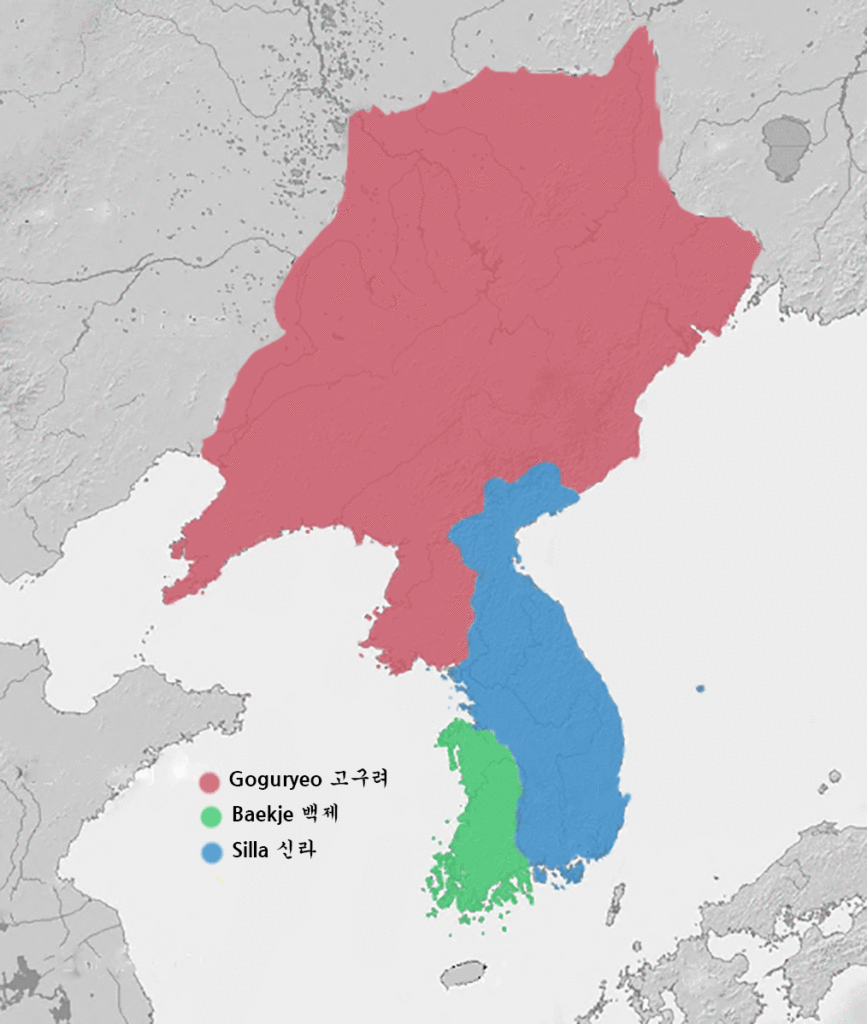
Next came the Goryeo Dynasty from 918 – 1392 AD which was founded by Wang Geon. Buddhism was adopted as the state religion leading to a melding of Buddhism and Confucianism among the people. At this time, dance and music were commonly used as tools of praise to celebrate royal leaders and give thanks and show admiration for their success and achievements. Buddhist events and holidays were celebrated by all and this was when music or other art forms brought people from all walks of life together. Then came the Joseon Dynasty (1392 – 1897). In this dynasty, Buddhism was deemed corrupt and replaced by neo-Confucianism. Although the state religion was changed to neo-Confucianism, many of the common folk still embraced Buddhism while the ruling class switched. Another cultural change was that art traditions began to favor realism over abstract concepts, something that was not common before this dynasty. Because of the state religion becoming neo-Confucianism, many Buddhist monks had to return to secular life. But instead of joining the common folk, they joined the artistic community instead and became Sadangpae (wandering monastic clowns). They began to perform dances at Buddhist temples to keep traditional folk and ritualistic dance alive. Court dances also thrived in this dynasty; of the 45 known dances, 30 were formed during this time. Silhak – a Confucian reform movement that stressed real life and practical learning over dreams and imagination was enacted; this influenced everything in society heavily. Also during this time, Chinese-style dances fell out of popularity, and dances that promoted a Korean identity were brought to the forefront. After the Joseon dynasty came 35 years of Japanese colonial rule and then the establishment of the Republic of Korea.
Korea in the 20th century came with heavy Western influences which caused Korean traditional culture to gradually disappear. This is why the Cultural Heritage Protection Act and the system of Important Intangible Cultural Heritage were enacted in 1962 to preserve their culture and traditions. Korean dance began to move from temples and courts to theaters due to Westernization; this is the first time that all of these dances have been performed in the same location. As well as this location change, the context of the performance changed. Dance was a way to honor the ruling class, celebrate, or perform rites, but with Westernization, dance became more of a large entertainment production. Since it became more about entertainment, new dances were created to fit a longer performance time. Not necessarily a whole new dance but more a medley of traditional Korean dances made into one.
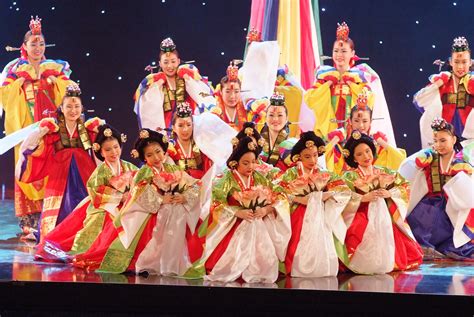
Due to Westernization, many non-Korean dances became infused into the culture. One of these dances was ballet which was introduced to Korea in the early 1900s but it wasn’t practiced until 1962 with the founding of the Korean National Ballet Company. This company performed classical pieces and original pieces that fused traditional Korean stories with the dance. Another dance that came to Korea was B-Boying; it first came to Korea in the 1970s by American TV shows that were brought by US soldiers. This dance began to gain popularity in club scenes but, in the 1970s, the government started a social purification campaign to maintain Korean identity. This led to B-Boying being banned and the dance style fell out of popularity quickly. But, with the election of President Kim Young-sam in the 1990s, this censoring was stopped. B-Boying reentered the Korean music scene and many Koreans gained international recognition for their B-Boying performances. The Korean government now embraces b-boy culture and has assigned several crews as official ambassadors of Korean culture.
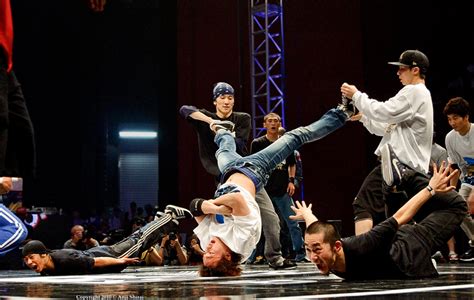
Written by Lexie Allen
Categories
Calendar
| M | T | W | T | F | S | S |
|---|---|---|---|---|---|---|
| 1 | 2 | 3 | 4 | |||
| 5 | 6 | 7 | 8 | 9 | 10 | 11 |
| 12 | 13 | 14 | 15 | 16 | 17 | 18 |
| 19 | 20 | 21 | 22 | 23 | 24 | 25 |
| 26 | 27 | 28 | 29 | 30 | 31 | |